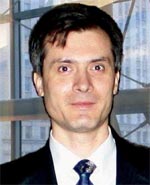Date
Cost
Free and open to the public
Location
Research Pavilion, Room 475 (NanoScience Technology Center)
Description
Over the past few years nanodiamond particles have attracted increased interest in the context of emerging biomedical applications, including theranostics platforms, which combine therapeutic and diagnostic modalities, protein mimics, tissue engineering scaffolds, and surgical tools and implants. These applications have become possible due to the unique properties, moderate cost, and available commercial production of detonation nanodiamond. The material is made of diamond particles, each of ~5 nm in diameter, combining chemically stable diamond core with fully accessible, reactive and tailorable surface. In addition, nanodiamond provides superior mechanical, optical, and thermal properties of bulk diamond at the nanoscale and is biocompatible and non-toxic carbon nanomaterial. This talk will highlight some of the recent developments in nanodiamond for biomedical applications.
Due to its nanoscale size and rich surface chemistry, nanodiamond is intensely studied as a versatile platform for drug delivery. Nanodiamond surface can be modified in many ways, providing an exceptional flexibility for choosing different mechanisms for drug loading and release, making possible to design smart stimuli responsive drug delivery systems.
Nanodiamond particles can be made fluorescent via surface modification or by designing defects in the diamond core, thus providing a non-toxic alternative to semiconductor quantum dots for in vivo biomedical imaging.
Small and uniform size, nearly spherical shape, and tailorable surface chemistry of nanodiamond particles are beneficial for creating protein mimics - solid highly stable nanoparticles capable of performing many of the structural, carrier, and enzymatic functions of the proteins.
Finally, superior mechanical properties of nanodiamond are indispensible for multifunctional polymer matrix nanocomposites, which can be used as tissue engineering scaffolds, bone implants, and in various surgical fixation tools.
Presenter

Vadym Mochalin, Ph.D.
Department of Materials Science & Engineering
A.J. Drexel Nanotechnology Institute
Drexel University
More information
Light refreshments will be served.
Contact
Mari Pina NanoScience Technology Center 407-882-1515 Mari.Pina@ucf.edu